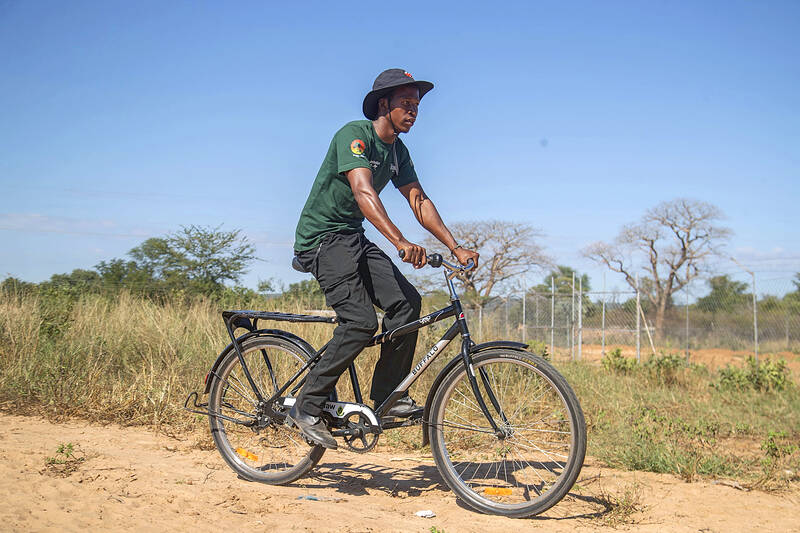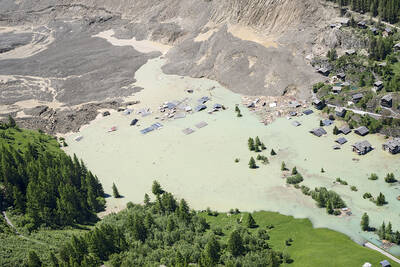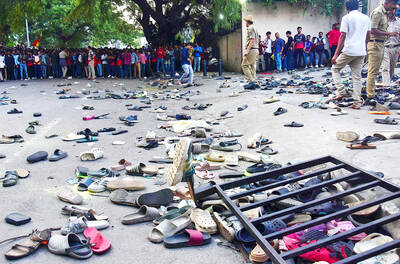When GPS-triggered alerts show an elephant herd heading toward villages near Zimbabwe’s Hwange National Park, Capon Sibanda springs into action. He posts warnings in WhatsApp groups before speeding off on his bicycle to inform nearby residents without phones or network access.
The new system of tracking elephants wearing GPS collars was launched last year by the Zimbabwe Parks and Wildlife Management Authority and the International Fund for Animal Welfare (IFAW). It aims to prevent dangerous encounters between people and elephants, which are more frequent as climate change worsens competition for food and water.
“When we started it was more of a challenge, but it is becoming phenomenal,” said Sibanda, 29, one of the local volunteers trained to be community guardians.

Photo: AFP
For generations, villagers banged pots, shouted or burned dung to drive away elephants. However, worsening droughts and shrinking resources have pushed the animals to raid villages more often, destroying crops and infrastructure, and sometimes injuring or killing people.
Zimbabwe’s elephant population is estimated at about 100,000, nearly double the land’s capacity.
However, the country has not culled elephants in close to four decades due to pressure from wildlife conservation activists, and because the process is expensive, parks spokesman Tinashe Farawo said.
From January to last month, conflicts between humans and wildlife such as elephants, lions and hyenas killed 18 people across Zimbabwe, forcing park authorities to kill 158 “trouble” animals during that period.
“Droughts are getting worse. The elephants devour the little that we harvest,” said Senzeni Sibanda, a local councilor and farmer.
Technology now supports the traditional tactics. Through the EarthRanger platform introduced by IFAW, authorities track collared elephants in real time. Maps show their proximity to the buffer zone — delineated on digital maps, not by fences — that separate the park and hunting concessions from community land.
At a park restaurant one morning, IFAW field operations manager Arnold Tshipa monitored moving icons on his laptop as he waited for breakfast. When an icon crossed a red line, signaling a breach, an alert pinged.
“We’re going to be able to see the interactions between wildlife and people,” Tshipa said. “This allows us to give more resources to particular areas.”
The system also logs incidents such as crop damage or attacks on people and livestock by predators such as lions or hyenas, and retaliatory attacks on wildlife by humans. It tracks the location of community guardians such as Capon Sibanda as well.
“Every time I wake up, I take my bike, I take my gadget and hit the road,” Sibanda said. He collects and stores data on his phone, usually with photos.
“Within a blink,” alerts go to rangers and villagers, he said.
His commitment has earned admiration from locals, who sometimes gift him crops or meat. He also receives a monthly food allotment worth about US$80 along with Internet data.
Villagers such as Senzeni Sibanda said the system is making a difference: “We still bang pans, but now we get warnings in time and rangers react more quickly.”
Still, frustration lingers. Senzeni Sibanda said she has lost crops and water infrastructure to elephant raids and wants stronger action.
“Why are you not culling them so that we benefit?” she asked. “We have too many elephants anyway.”
Her community, home to several hundred people, receives only a small share of annual trophy hunting revenues, roughly the value of one elephant or between US$10,000 and US$80,000, which goes toward water repairs or fencing.
She wants an increase in Zimbabwe’s hunting quota, which stands at 500 elephants per year, and her community’s share increased.
“A WAY FORWARD”
Zimbabwe’s collaring project may offer a way forward. Sixteen elephants, mostly matriarchs, have been fitted with GPS collars, allowing rangers to track entire herds by following their leaders.
In a recent collaring mission, a team of ecologists, vets, trackers and rangers identified a herd. A marksman darted the matriarch from a distance. Team members fitted the collar on the elephant, while some collected blood samples. Rangers with rifles kept watch.
Once the collar was secured, an antidote was administered and the matriarch staggered off into the wild, flapping its ears.
“Every second counts,” parks agency veterinarian Kudzai Mapurisa said.

The collapse of the Swiss Birch glacier serves as a chilling warning of the escalating dangers faced by communities worldwide living under the shadow of fragile ice, particularly in Asia, experts said. Footage of the collapse on Wednesday showed a huge cloud of ice and rubble hurtling down the mountainside into the hamlet of Blatten. Swiss Development Cooperation disaster risk reduction adviser Ali Neumann said that while the role of climate change in the case of Blatten “still needs to be investigated,” the wider impacts were clear on the cryosphere — the part of the world covered by frozen water. “Climate change and

Packed crowds in India celebrating their cricket team’s victory ended in a deadly stampede on Wednesday, with 11 mainly young fans crushed to death, the local state’s chief minister said. Joyous cricket fans had come out to celebrate and welcome home their heroes, Royal Challengers Bengaluru, after they beat Punjab Kings in a roller-coaster Indian Premier League (IPL) cricket final on Tuesday night. However, the euphoria of the vast crowds in the southern tech city of Bengaluru ended in disaster, with Indian Prime Minister Narendra calling it “absolutely heartrending.” Karnataka Chief Minister Siddaramaiah said most of the deceased are young, with 11 dead

Poland is set to hold a presidential runoff election today between two candidates offering starkly different visions for the country’s future. The winner would succeed Polish President Andrzej Duda, a conservative who is finishing his second and final term. The outcome would determine whether Poland embraces a nationalist populist trajectory or pivots more fully toward liberal, pro-European policies. An exit poll by Ipsos would be released when polls close today at 9pm local time, with a margin of error of plus or minus 2 percentage points. Final results are expected tomorrow. Whoever wins can be expected to either help or hinder the

DENIAL: Musk said that the ‘New York Times was lying their ass off,’ after it reported he used so much drugs that he developed bladder problems Elon Musk on Saturday denied a report that he used ketamine and other drugs extensively last year on the US presidential campaign trail. The New York Times on Friday reported that the billionaire adviser to US President Donald Trump used so much ketamine, a powerful anesthetic, that he developed bladder problems. The newspaper said the world’s richest person also took ecstasy and mushrooms, and traveled with a pill box last year, adding that it was not known whether Musk also took drugs while heading the so-called US Department of Government Efficiency (DOGE) after Trump took power in January. In a